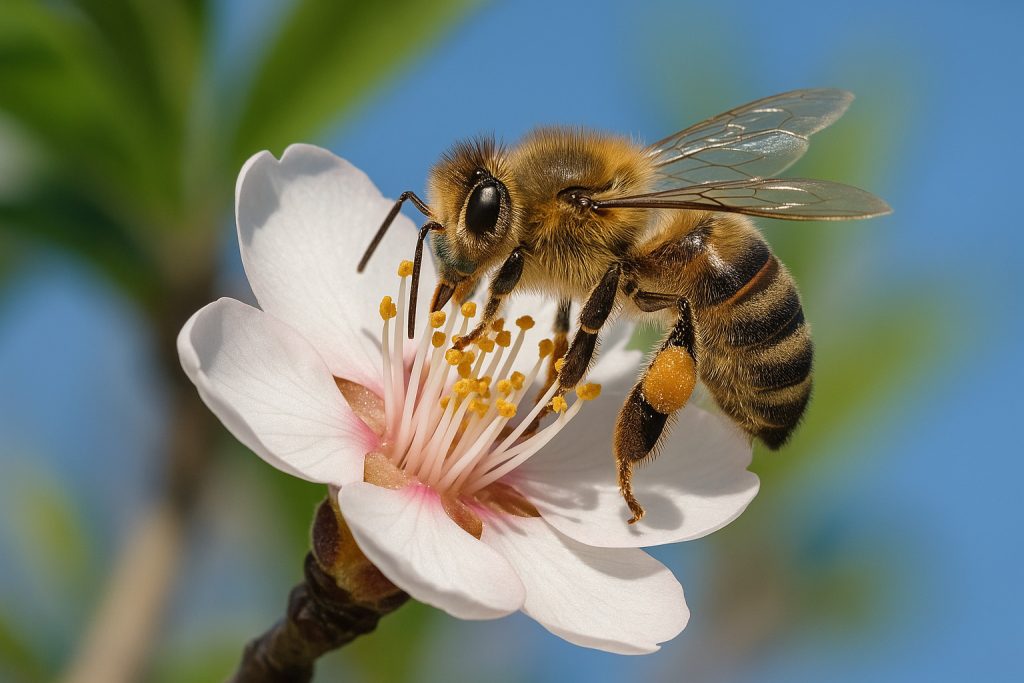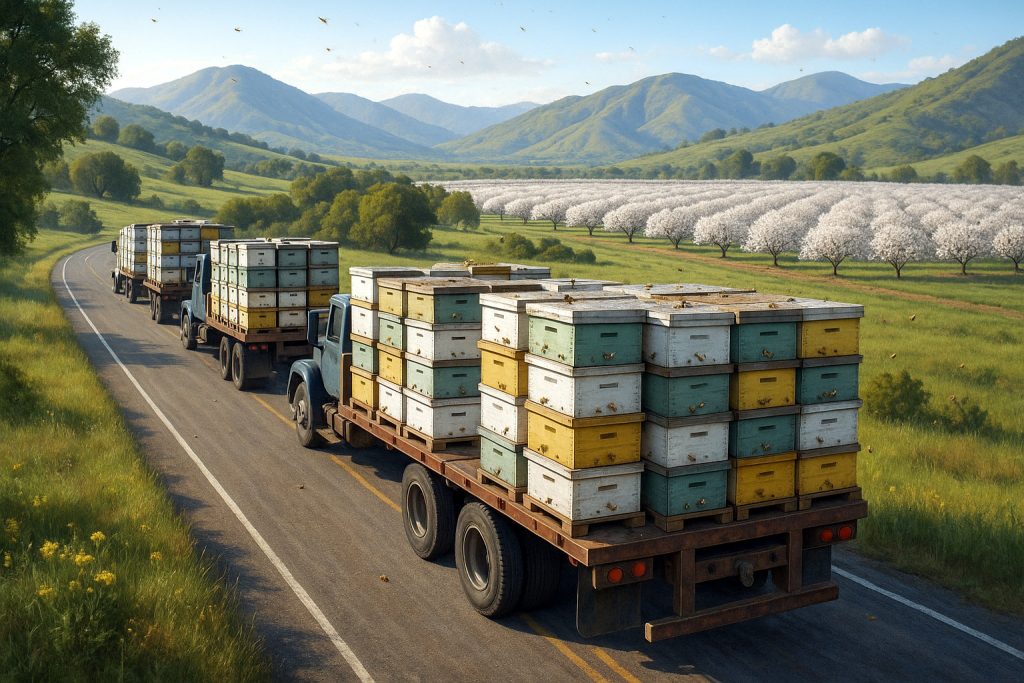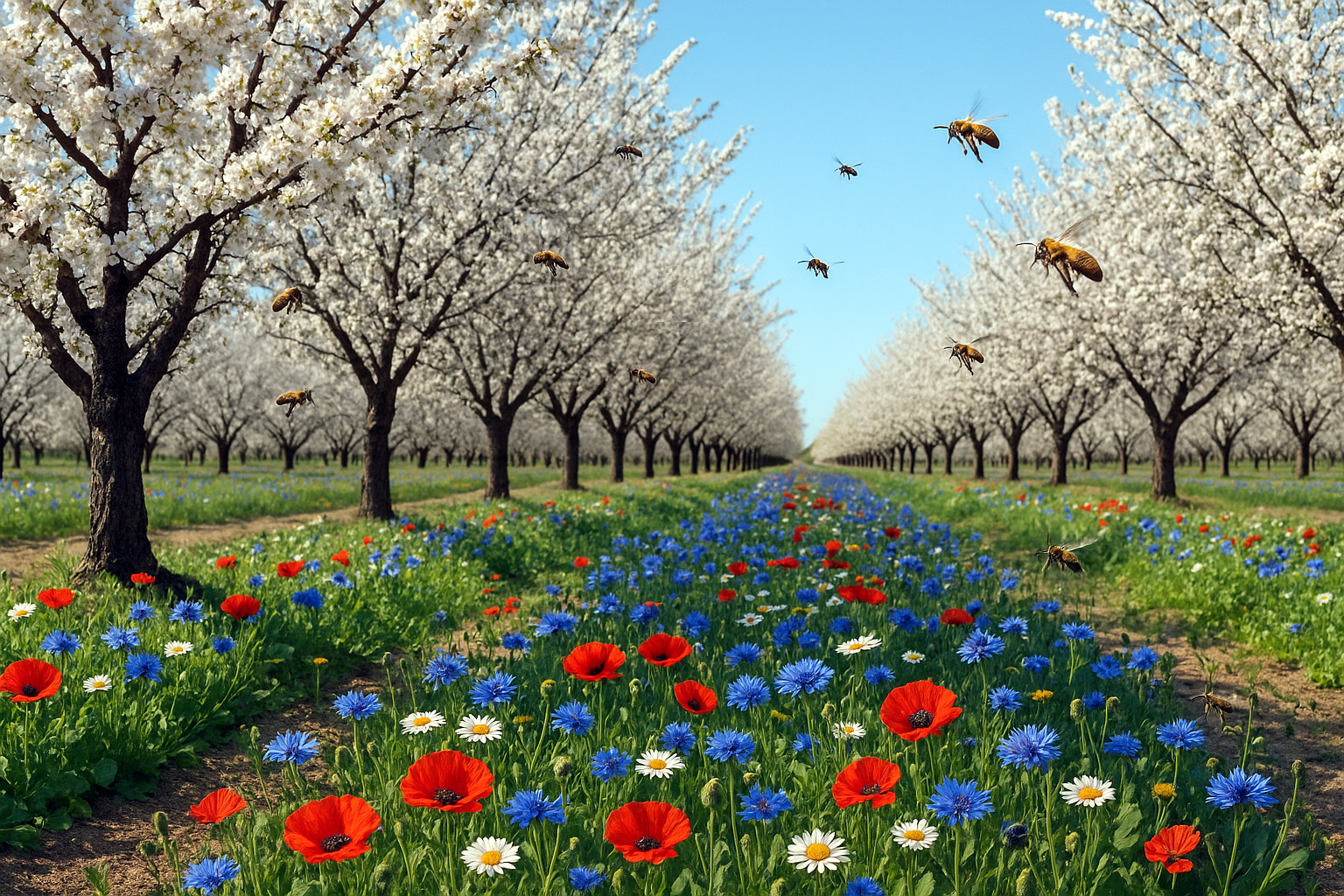Every Almond Owes Its Life to a Bee
Next time you crunch an almond, take a moment to thank a bee. Seriously! Without honey bees, California’s almond orchards would be out of business, trail mix would be less exciting, and “almond milk latte” would be… just “latte.” Here’s the surprising, slightly wild, and sometimes challenging story of how your favorite nut gets from blossom to snack bowl.
The Almond Challenge: A Numbers Game
Did you know California produces about 80% of the world’s almonds? That’s a lot of nuts—and every single almond requires pollination.
Almond trees can’t pollinate themselves or each other; they need help, and only honey bees can do the job at scale. Growers need about two hives per acre to get the job done. Multiply that by over 1.6 million acres of orchards and… you need more than 2 million bee hives every spring! That’s over half of all the managed honey bees in America packed into California for a few short weeks.
(USDA ARS, UC Davis, Almond Board of California)

The Great Bee Migration: Pollinators on the Road
So, how do you get two million bee hives to California in time for almond bloom? With a nationwide “bee road trip.”
Every January and February, beekeepers from as far away as Florida, Maine, and the Midwest pack their hives onto flatbed trucks and hit the highways—often driving at night while the bees are home and calm. Once the bees arrive, they turn quiet winter orchards into a buzzing, living cloud of pollinators.
For beekeepers, this is the Super Bowl of pollination—a time of long hours, careful driving, and the biggest paycheck of the year.
(NPR, NYT)

Why Almond Pollination Is So Tough on Bees
While almonds are great for business, they’re actually a mixed blessing for the bees:
- Monoculture Diet: Imagine eating only pizza for a month. Almond pollen is nutritious—but bees need a varied diet to stay healthy, and the orchard is a one-crop buffet.
- Pesticide Problems: Almonds are a valuable crop, so they get treated for pests. Even “bee-friendly” sprays can mess with hive health.
- Bee Crowding: Two million hives in one area means bees from all over mingle, sharing not just pollen but also diseases and parasites—like the dreaded Varroa mite.
- Post-Bloom Blues: When the almond flowers drop, there’s suddenly nothing left to eat. Hives often leave California stressed, sick, and sometimes much smaller than when they arrived.
So, yes—almond pollination can be rough for our little winged heroes.
(Bee Informed Partnership, UC ANR, National Geographic)
A Sweeter Deal for Bees: How Growers and Shoppers Can Help
But don’t feel guilty about that almond milk yet—there’s a lot of hope, too! Many farmers and scientists are working together to make almond pollination friendlier for bees:
- Bee-Friendly Almonds: Some orchards plant wildflowers and cover crops between the rows, giving bees extra nutrition before and after the almond bloom.
- Pesticide Progress: New best practices keep most chemicals away from bees, or at least out of the hive’s way.
- Consumer Choices: You can look for almonds (and almond products) labeled as “bee-friendly” or “pollinator-friendly.”
(Almond Board of California, NPR)
The future? Scientists are even experimenting with native pollinators (like the blue orchard mason bee), new hive nutrition techniques, and smarter planting schedules to keep our bees healthy and our almond supply secure.
From the Orchard to Your Eaves: Why Local Bees Matter, Too
By now, you know just how much pressure commercial bees are under—shipped cross-country, exposed to one-crop diets, and facing more stress than ever before. But what about the bees buzzing in your own neighborhood?
The truth is, every healthy local bee colony is more valuable than ever.
The wild hive in your tree, the honey bees behind your shed, or even the fuzzy bumblebees visiting your garden—they’re all part of a fragile, interconnected ecosystem. With so many commercial hives facing disease, pesticides, and grueling road trips, our local bees help carry the torch for pollination right here at home.
That’s why at Bee Removal Phoenix by Busy Bee Pest Solutions, our mission goes beyond just keeping homes safe. Whenever possible, we use live bee removal and relocation instead of extermination. Saving a local colony isn’t just good karma—it’s a way to support biodiversity, preserve vital pollinators for neighborhood gardens, and do our part for a global food system that depends on every single bee.
So, if you discover a hive in your wall, eaves, or backyard, don’t see it as a simple nuisance. See it as a tiny, winged ally in the great pollination story—and know that our team is ready to help both you and the bees.
🥜 Final Thought: Respect the Almond, Thank the Bee
Next time you snack on an almond, remember: it took a cross-country bee road trip, weeks of pollinator teamwork, and a lot of human ingenuity to make it possible. Almonds aren’t just a snack—they’re a tiny triumph of teamwork between humans and honey bees.
Sources & Further Reading
- USDA – Honey Bees and Almond Pollination
- UC Davis – Almond Pollination FAQs
- Almond Board of California – Pollination
- USDA NASS – Almond Acreage Report
- NPR – For Almond Pollination, Beekeepers Hit the Road
- Bee Informed Partnership – Almond Pollination and Hive Losses
- UC ANR – Monoculture Diet & Bee Nutrition
- National Geographic – The Almond-Pollination Problem
- NPR – Bee-Friendly Almonds
